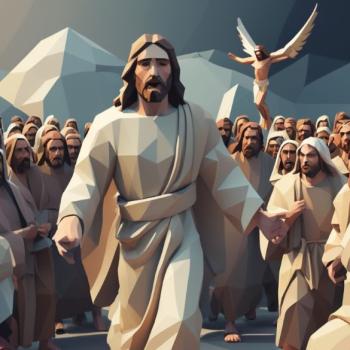When it comes studying the Gospels with a full assortment of scholarly tools like textual criticism, source criticism, genre criticism, literary criticism, narrative criticism, and redaction criticism, I find that many young evangelical students in their first few courses get rather edgy or even irritated when exposed to them. They seem very uneasy with things such as the Synoptic problem, textual suspicion about the story of the woman caught in adultery, Matthew’s re-judaizing of Mark, debates about the authenticity of this or that saying, discussing parallels between the birth narratives of Jesus and Alexander the Great, and so forth. I find that many of these students are happy to read Lee Strobel’s popular apologetic book The Case for Christ, but often feel violated when they are asked to read B.H. Streeter’s The Four Gospels or Albert Schweitzer’s The Quest of the Historical Jesus. How does all of this scholarly stuff square with a view of Scripture as inspired, infallible, containing a message of salvation, and embodying our Christian hopes? Good question![1]
I have to say that there are two approaches to the Gospels which I ardently despise. First, some über-secularists want to read the Bible as nothing more than a deposit of silly ancient magic, mischievous myths, whacky rituals, and surreal superstitions. They engage in endless comparisons of the Bible with other mythic religions to flatten out the distinctive elements of the story. Added to that is advocacy of countless conspiracy theories to explain away any historical elements in the text. This approach is coupled with an inherent distaste for anything supernatural, pre-modern, and wreaking of religion. Such skeptics become positively evangelical in their zealous fervor to prove that nothing in the Bible actually happened. Second, then there are those equally ardent Bible-believers who want to treat the Bible as if it fell down from heaven in 1611, written in ye auld English, bound in pristine leather, words of Jesus in red, complete with Scofield footnotes, and charts about the end-times. Such persons regard exploring topics like Johannine chronology just as religiously affronting as worshipping a life size golden statue of Barack Obama. Now I have to say that both approaches bore the proverbial pants off me. They are equally dogmatic as they are dull. They are uninformed as they are unimaginative. There is another way!
My own approach is what I would term “believing criticism.”[2] This approach treats Scripture as the inspired and veracious Word of God, but contends that we do Scripture the greatest service when we commit ourselves to studying it in light of the context and processes through which God gave it to us. Scripture is trustworthy because of God’s faithfulness to his own Word and Scripture is authoritative because the Holy Spirit speaks to us through it. Nonetheless, God has seen fit to use human language, human authors, and even human processes as the means by which he has given his inscripturated revelation to humanity. To understand the substance of Scripture means wrestling with its humanity, the human face of God’s speech to us in his Word. That requires that we can freely engage subjects such as sources that the Evangelists used (source criticism), when were the Gospels written and where (historical criticism), why were the Gospels written (literary criticism), what kind of literature did they think they were writing (genre criticism), how have the Evangelists edited and adapted their sources (redaction criticism), how does the story in its current shape create meaning (narrative criticism), how was the text of the Gospels transmitted (textual criticism), and how did the Gospels come to be accepted as the four official stories of Jesus sanctioned by the councils of the early church (canonical criticism)? These are legitimate inquiries to be made, not in spite of but precisely in light of, the faith communities who cherished the Gospels as testimonies to Jesus Christ.
What is more, when we say that the Gospels are historically reliable, we do not mean that they were intended to be judged by the standards of modern historiography or that they are the ancient equivalent of what it would have been like to follow Jesus around with a hidden video camera. They are historically rooted in the memories of the earliest eyewitnesses. Let me say also that even if ancient writers did not have the apparatus of modern history writing –footnotes, plagiarism software, video footage, and editorial boards –they still knew the difference between events purported to have happened, but didn’t, and events purported to have happened and did happen. St. Luke, the Beloved Disciple, and the author of 2 Peter, all believe that the Jesus-story is not make-believe (Luke 1:1-4; John 19:35; 20:31; 2 Pet 1:16). After due allowances are made for the artistic license, theological embellishment, and inherent biases of the tradents of the tradition, our witnesses to Jesus remain steadfast in their conviction that the Jesus whom they narrate is historically authentic as much as he is personally confronting. That is why the story of Jesus given in early Christian testimony is placed in a specific context that offers both a historical referent as well as explicating the history of Jesus in a religious narrative about God, Israel, and the kingdom of God. Larry Hurtado sets out wonderfully both the historical reality and narrative texture of the Gospels:
In short, this all amounts to a shared programmatic effort to locate Jesus in a specific historical, geographical, and cultural setting. It represents an insistence that the Jesus whom the writers and intended readers of these Gospels reverenced (who include Gentile and Jewish believers in various locations in the Roman world), and were to see as linked with God’s purpose in a unique way, is quite definitely Jesus of Nazareth. He is not some timeless symbol, not a mythical figure of a “once upon a time,” but instead very specifically a Jew whose life and activities are geographically and chronologically located in a particular place and period of Jewish history in Roman Judea … [T]he canonical Gospels emphasize an explicit, larger “narrative world” or the story line into which they place their stories of Jesus. This narrative horizon extends both backward to include the story line of the Scriptures of Israel (Tanach/Old Testament) and forward chronologically to the eschatological triumph of God’s purposes … If the biblical sweep of the horizon “backward” in time gives the meaning-context of Jesus, the eschatological sweep of the horizon “forward” holds out the hope in which following Jesus is to be ventured, and the divine purpose that Jesus serves.[3]
We might add that all history, both ancient and modern, is interpreted. There is no unbiased reporting, nor any purely objective history, whether that is by St. Matthew, Oxford University Press, or the New York Times. Furthermore, the Gospels are not interested in brute facts, mere data, statistics, or opinion polls when it comes to Jesus. They are also theologically oriented. To the point that: “The story of Jesus is the continuation and actualization of the story of God.”[4] Though the Gospels have an interest in the back-then-ness of Jesus, his earthly life and pre-Easter ministry, they still tell the story from the perspective of people who believe that Jesus is also the risen and exalted Lord.
Thus, the historical Jesus and the theologically significant Jesus are treated as one and the same by the Evangelists. Indeed, this is precisely why it is so difficult in the Gospels, even near impossible, to separate the Jesus of history from the Jesus of the church’s faith. It is like trying to separate red and blue from the color purple.[5] The history of Jesus is available to us primarily, though perhaps not exclusively, through the theological testimony of the early church to Jesus. The Gospels are not just about what Jesus actually did and said, but who Jesus is and will yet be in the grand purpose of the God of Israel to bring life and justice to his creation.
This means that we are actually liberated to read the Gospels as they were intended to be read: as historically referential theological testimonies to Jesus as the exalted Lord. It does not matter then whether there was one demoniac (Mark 5:2; Luke 8:27) or two demoniacs (Matt 8:28) that Jesus healed on the eastern shore of the Sea of Galilee. Jesus healed a demon possessed man in the vicinity and Matthew just likes couplets, making everything two’s where he can! Similarly, trying to prove that mustard seeds really are the smallest plants of the earth (Mark 4:31) or that Peter denied Jesus three times before the cock first crowed and then three times again afterwards (Matt 26:69-74; Luke 22:56-60; John 18:16-27; Mark 14:66-68) is like trying to understand the Magna Carta by arguing about whether the commas are in the right position. John Calvin himself said: “We know that the Evangelists were not very exact as to the order of dates, or even in detailing minutely everything that Christ did or said.”[6] The Evangelists give us the big picture about Jesus, the gist of his words, the major outlines of his career, they position him in relation to the prophetic promises, and they declare the all important significance as to who he was and why he died. The details should not be treated with indifferences, but they are not the focus of the stories we call “Gospels.” While I think the overall historical reliability of the Gospels is vitally important less we treat Gospels as religiously laden fiction, we should not import anachronistic and modernist criteria of historical reality into our treatment of the Gospels and make it a condition for theological validity: Martin Hengel lamented how an
unbiblical, and ultimately rationalistic, apologetics remained the rule in Protestant orthodoxy until the beginning of historical criticism in the eighteenth century, and indeed in some evangelical fundamentalist circles to the present day. Such a “fundamentalistic rationalistic” exegesis which makes the New Testament a law book does little service to the real historical and theological understanding of the Gospels (the two cannot be separated) as the radical ahistorical scepticism which seeks to investigate the text only by a literary approach in terms of its aesthetic value or by a dogmatic approach in terms of its unalterable fixed “truth content” and prohibits any authentic historical investigation, or at least is not interested in it.[7]
The four canonical Gospels stand as a theological unity in their witness to Jesus and as a canonical authority for those who claim to follow Jesus as their Lord. To treat the Gospels as Scripture does not obligate us to explain away their distinctive narration, to flatten out their individuality, to harmonize every apparent discrepancy, or to play down their unique portraits of Jesus. The Gospels should be studied and admired like four stain glass windows of Jesus in a cathedral, where each portrait displays the same person, but expresses his personality and identity in different ways. No single portrait is any “truer” than the others, but it is as a unity that they together provide us with the complete array of images that make up the Jesus of the church’s faith. Along these lines the church father Augustine said:
If you ask which of these different versions [of the Gospels] represent what was actually expressed by the voice, you may fix on whichever you wish, provided that you understand that those of the writers who have not reproduced the identical form of speech have still reproduced the same sense intended to be conveyed. And these variations in the modes of expression are also useful in this way, that they make it possible for us to teach a more adequate conception of the saying than might been the case with only one form, and that they also secure it against being interpreted in a sense not consonant with the real state of the case.[8]
For Augustine it is the rich diversity in the portraits of Jesus given to us by the Evangelists that enable us to grasp more fully and more firmly who Jesus actually is!
So then, how do we as a believing and confessing community approach the critical questions that the texts of the Gospels present to us? First, we begin with a hermeneutic of trust. We trust Jesus and Jesus evidently trusts the Scriptures that point to him. God’s Word is attested by God’s Son and this Word is further validated by the inner witness of the Holy Spirit that it is always true and trustworthy. Second, we need to get our hands and feet dirty in the mud and muck of history. Jesus is not an ahistorical religious icon who can be deciphered entirely apart from any historical situation. On the contrary, Jesus could not have been born as savior of the world somewhere in the Amazon rainforest or in the Gobi desert. He came to Israel and through Israel, to make good God’s promises to save the world through a renewed Israel. So, whether we like it or not, we are obligated to study Jesus in his historical context. I would go so far to say that this is even a necessary task of discipleship.[9] For it is in context of Israel’s scripture and in the socio-political circumstance of Roman Palestine that Jesus is revealed as the Messiah and Son of God. So unless we are proponents of a docetic christology where Jesus only seems human, we are committed to a study of the historical person Jesus of Nazareth in his own context. That means archaeological, social-historical, and cultural studies of the extant sources as far as they are available to us. It means immersing ourselves in as much of the primary literature of the first century as we can get our hands on– Jewish, Greek, and Roman – so that we can walk, talk, hear, and smell the world of Jesus. It entails we go through the Gospels unit by unit and ask what exactly did Jesus intend and how would his hearers have understood him. It equally entails asking why the Evangelists have told the story this way and why do they have the peculiarities that they do. Third, we have to explore the impact that the Gospels intended to make upon their implied readers and how the Four Gospels as a whole intend to shape the believing communities who read them now.
So, when it comes to the hard and even treacherous “critical” questions, in the words of Bruce Chilton: “A primary evangelical and critical task is, not to peddle our assumptions, but to encourage the sort of open, detailed inquiry which will vindicate them.”[10] Second, when it comes to reading the Gospels as a church community, we are not just mining for nuggets of devotional wisdom, rather, we are striving to let the story of Jesus gradually shape our lives, enrich our worship, inspire us to mission, draw our community together, and impact our ministries, so that the Evangelical vision of Jesus given to us in the Gospels becomes an evangelical project to make the story of Jesus known in all the world.
—————————–
[1] Of course, I’ve also lectured in university surroundings where students sometimes came along thinking that I was going to debunk all this Jesus non-sense as a load of fictitious hokum and their consternation becomes quite evident when they discover that Jesus is more historically accessible to us than are many other figures from antiquity. What is more, they are even more concerned to discover that everything that they thought they knew about Jesus is based on an ill informed media, a biblically illiterate education, and owes more to the Simpsons than to Christian Scripture.
[2] Cf. Mark Noll, Between Faith and Criticism: Evangelicals, Scholarship, and the Bible in America (Vancouver: Regent College, 1988), 163-80.
[3] Larry Hurtado, Lord Jesus Christ: Devotion to Jesus in Earliest Christianity (Grand Rapids, MI: Eerdmans, 2003), 266-68.
[4] Joel B. Green, “The Gospel according to Mark,” in The Cambridge Companion to the Gospels, ed. Stephen C. Barton (Cambridge: CUP, 2007), 147.
[5] A point made recently and quite notably by Dale C. Allison, The Historical Christ and the Jesus of Faith (Grand Rapids,MI: Eerdmans, 2009).
[6] John Calvin, Commentary on a Harmony of the Evangelists (Grand Rapids, MI: Eerdmans, 1989), 216
[7] Hengel, The Four Gospels and the One gospel of Jesus Christ, 23-24.
[8] Augustine, Harmony of the Evangelists, 2.14.31.
[9] N.T. Wright, The Challenge of Jesus (London: SPCK, 2000), 14-15; and see exploration of this point more fully in Michael F. Bird, “Should Evangelicals Participate in the ‘Third Quest for the Historical Jesus’?” Themelios 29.2 (2004), 4-14.
[10] Bruce D. Chilton, “An Evangelical and Critical Approach to the Sayings of Jesus,” Them 3 (1978), 85.















